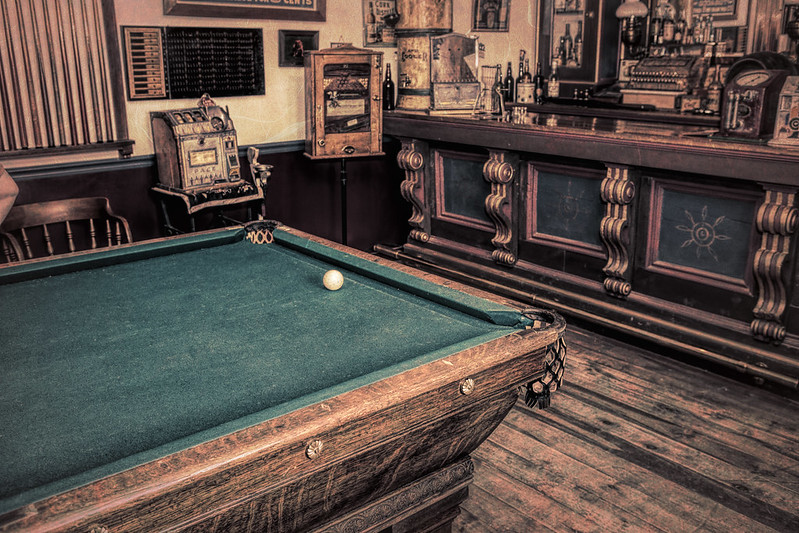Welcome to the enchanting world of vintage pool tables – timeless treasures that capture the essence of eras gone by.
Today we’re celebrating the rich history and exquisite craftsmanship of these heirlooms. Additionally, you’ll fine guidance through the nuances of restoration, sourcing parts, and conserving them for future generations to cherish.

Photo Credit: Scott Sanford, Flickr
1. The Artistry of Vintage Pool Tables
A Journey Through Time:
The evolution of pool tables mirrors the societal and artistic trends of their times.
In the 19th century, Victorian tables boasted lavish designs with intricate woodwork and ornate inlays, reflecting the era’s penchant for elaborate decoration.
As we moved into the 20th century, the Art Deco movement influenced table designs. It led to the more streamlined and simplified appearance we often see in modern tables.
This Art Deco movement, which gained prominence in the 1920s and 1930s, was characterized by sleek geometric forms and a shift away from the ornate and elaborate designs that marked the Victorian and Edwardian eras.
Art Deco’s influence on pool table design can be seen in several key ways:
1. Simplification of Form:
Unlike the heavily carved and ornately decorated tables of the past, Art Deco-inspired pool tables embraced simpler, cleaner lines. This was in line with the overall Art Deco ethos of elegance through simplicity and symmetry.
2. Use of New Materials and Colors:
Art Deco designers were known for experimenting with new materials and bold colors. In pool tables, this meant the incorporation of metals, inlays of exotic woods, and the use of vibrant felt colors, contrasting with the traditional green.
3. Geometric Patterns:
The characteristic geometric shapes of Art Deco, such as zigzags, chevrons, and streamlined curves, found their way into the design of pool tables, reflecting the modernist aesthetic of the time.
4. Functionality:
There was a greater emphasis on functionality in Art Deco designs. Pool tables designed in this era were not just decorative pieces; their design focused on enhancing the player’s experience, balancing aesthetic appeal with practicality.
While Art Deco played a pivotal role in transitioning to modern styles, it’s important to note that the evolution of pool table design has been influenced by many other styles and technological advancements over the years.
Today’s tables continue to reflect a mix of historical influences and contemporary design trends.
Craftsmanship in Detail:
The making of vintage pool tables was an art form.
Skilled artisans used rare woods like mahogany and oak, ensuring durability and elegance. The intricate inlays and carvings often tell a story or signify the status of the owner.
Unlike today’s tables, these vintage pieces were largely handcrafted, making each table unique.
Identifying Vintage Pool Tables
Maker’s Marks and Signatures:
Recognizing the maker of your vintage pool table can significantly influence its value and historical significance.
Look for maker’s marks, usually found on the table’s underside or inside the frame. Brands like Brunswick or J.E. Came often left distinct signatures or plaques.
Estimating Age and Value:
The age of a pool table can be gauged by design elements like leg style or wood type.
Consult with antique experts or use online databases for age estimation. The value hinges on factors such as rarity, condition, and historical significance.
In this situation, rather than guessing, having your table appraised by a professional would be best. Plus, it can give you a clear understanding of its truly worth.
Restoration Techniques
When to Restore vs. Preserve:
Deciding between restoration and preservation depends on the table’s condition and historical value.
On condition that the table is in relatively good shape and maintaining its originality is key, preservation might be the best route. Although, restoration is suitable for tables needing significant repair, as well. However, it’s important to keep changes true to the original style.
Do’s and Don’ts of Restoration:
- Do consult with restoration experts who specialize in vintage pool tables. Use period-appropriate materials and techniques.
- Don’t rush the process or use modern adhesives or finishes that can detract from the table’s authenticity.
Sourcing Replacement Parts for Vintage Pool Tables
Authentic vs. Reproduction Parts:
Finding the right parts for your vintage pool table can be challenging.
For authentic restoration, hunt for period-correct parts through antique dealers, online auctions, or specialized restorers.
Reproduction parts should be used as a last resort and chosen carefully to match the original style as closely as possible.
You can get started with your search simply by googling it.
Network of Experts:
Building a network with other vintage pool table enthusiasts, joining online forums, and connecting with professional restorers can provide invaluable resources for sourcing parts and advice.
Caring for Your Vintage Pool Table
Maintenance Tips:
Regular maintenance is vital.
Dust the wood and felt gently, avoid harsh chemicals, and keep the table away from direct sunlight and moisture.
For slate surfaces, ensure they remain level for optimal play.
Showcasing Your Table:
Display your vintage pool table in a space that complements its style. Consider the room’s decor, lighting, and space to create a harmonious setting that highlights the table’s uniqueness and beauty.
Vintage Pool Tables – A Legacy to Cherish
By caring for vintage pool tables with respect and attention, we ensure that these symbols of craftsmanship and social history continue to be admired and enjoyed.
Of course, these beauties are more than just antiques; they are a connection to the past.
